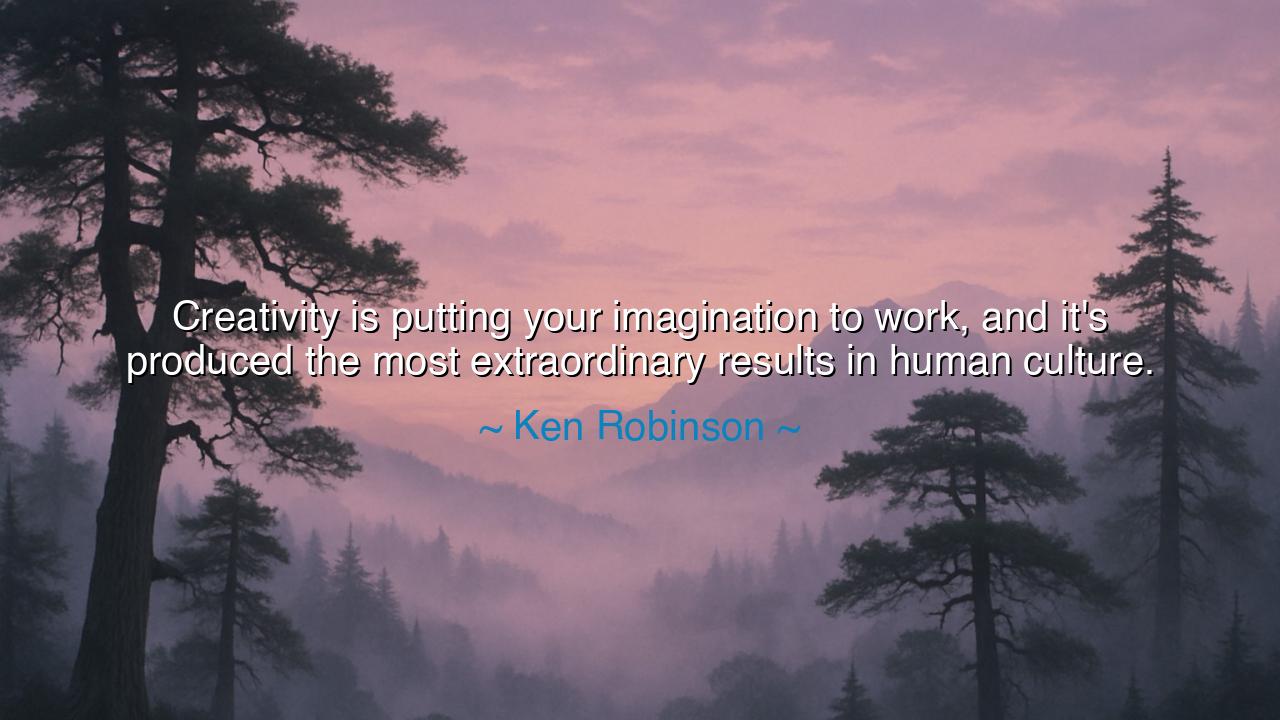
Creativity is putting your imagination to work, and it's produced
Creativity is putting your imagination to work, and it's produced the most extraordinary results in human culture.






“Creativity is putting your imagination to work, and it’s produced the most extraordinary results in human culture.” Thus spoke Sir Ken Robinson, the great teacher and philosopher of creativity, whose voice became a call to awaken the sleeping genius within every soul. In this simple but profound truth, he revealed the eternal law that has shaped civilizations: that imagination alone is potential, but creativity is its fulfillment. Imagination is the seed; creativity is the fruit. For imagination allows us to see what could be—but it is only when we act upon it, when we put imagination to work, that we participate in the divine act of creation itself.
This quote arises from the heart of Robinson’s lifelong work as an educator and thinker. He saw that the modern world, in its pursuit of order and conformity, had forgotten the sacred fire of imagination—that schools taught knowledge, but seldom the courage to create. To him, creativity was not the luxury of the gifted few, but the birthright of every human being. In his words and teachings, he sought to restore to the world the understanding that creativity is not something separate from reason, but the very life of it—the power by which knowledge becomes invention, and thought becomes art. His vision was that every mind, however ordinary it may seem, holds the power to bring forth something extraordinary if only it dares to act upon its imagination.
The ancients knew this truth long before our age of machines. The Greeks spoke of poiesis, the act of bringing into being that which did not exist before. The Egyptians carved eternity into stone because they imagined what the soul might need after death. The first humans who struck flint to fire did not do so by accident; they did so by vision—by seeing in the cold stone the hidden spark. Every temple, every symphony, every law of science was born from the same act of courage: the choice to transform imagination into creation. Thus, Ken Robinson’s words are not new—they are the echo of an ancient song, reminding us that what we imagine we are commanded to bring forth.
Consider the story of Leonardo da Vinci, whose life is a living testament to Robinson’s truth. Leonardo imagined flying machines centuries before humanity ever took to the air. He studied the flight of birds, drew sketches of wings and rotors, and saw possibilities others dismissed as madness. Though his designs would not soar in his lifetime, his act of creation set into motion a lineage of innovation that would one day lift humanity into the skies. Creativity, as Robinson declares, is not merely imagining flight—it is the act of building wings. And in this, Leonardo teaches us that imagination without action is a dream, but creativity transforms that dream into destiny.
The results of this union between imagination and action are indeed extraordinary. Every leap of culture—from cave painting to space travel, from the poetry of Homer to the algorithms that map the stars—has been the child of creativity. It is the bridge between the invisible and the visible, the unknown and the known. When we look upon the works of human civilization—the cathedrals, the music, the inventions—we are witnessing the evidence of imagination made real, of countless souls who refused to leave their visions unrealized. Through their courage to act upon their imagination, they lifted the whole of humanity forward.
Yet Robinson’s words also carry a warning. He reminds us that imagination unused becomes stagnant, that to dream and never create is to deny one’s purpose. The empty imagination, left idle, fills with fear and doubt; but when set to work, it becomes the source of joy, progress, and renewal. The mind that creates is never wasted—it is alive, awake, and connected to the pulse of creation itself. Thus, each of us must learn not merely to imagine, but to practice creativity daily—to think, to make, to shape, to risk, to build, even in small ways. For in every act of making, we join the lineage of those who shaped the world before us.
O seeker of truth, remember this: imagination is the vision of the heart, but creativity is the labor of the soul. To live without imagination is to see the world as it is; to live without creativity is to leave it unchanged. Do not wait for perfection, nor fear the laughter of the unimaginative. Begin your work, however humble, and let your imagination guide your hands. For every poem unwritten, every song unsung, every idea unacted upon leaves the world dimmer than it might have been. The extraordinary results of culture are not gifts from the heavens, but offerings from human hearts that dared to create.
Therefore, let this be your lesson: put your imagination to work. Write the story, paint the image, build the bridge, teach the child, heal the wound—create something that did not exist before you. For as Ken Robinson taught, creativity is not the privilege of the few; it is the calling of all who live. It is through creativity that humanity renews itself, generation after generation. To imagine is divine; to create is to honor that divinity. And when you act upon your imagination, you, too, become part of that endless and holy work that has shaped the stars, the songs, and the very soul of humankind.






AAdministratorAdministrator
Welcome, honored guests. Please leave a comment, we will respond soon